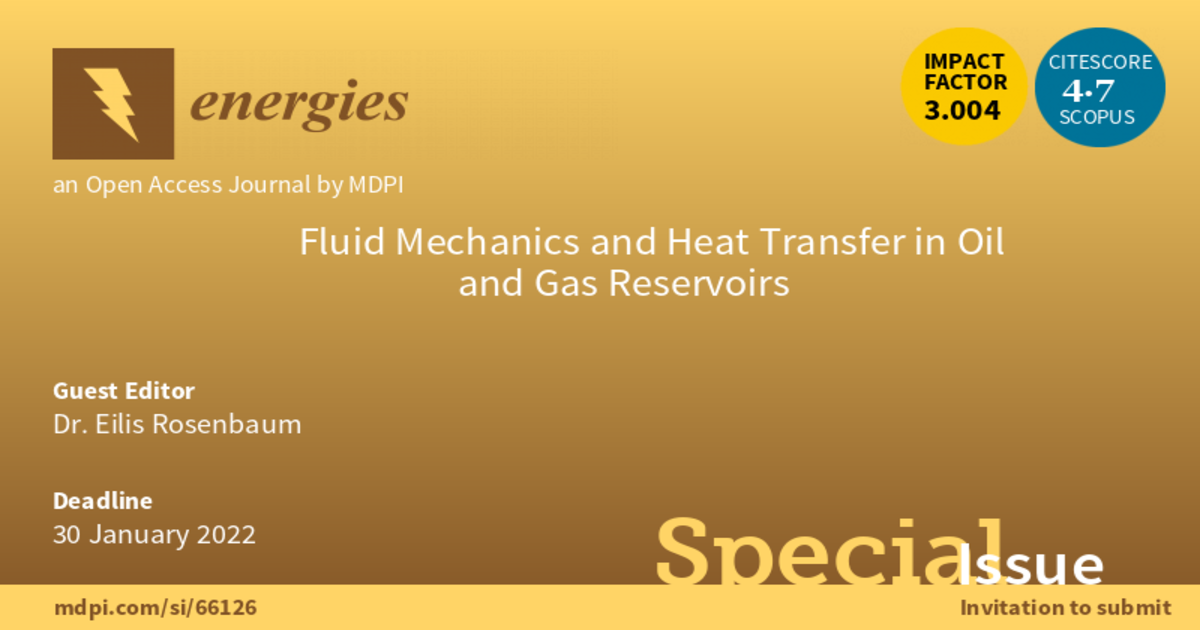Fluid Mechanics and Heat Transfer in Oil and Gas Reservoirs
A special issue of Energies (ISSN 1996-1073). This special issue belongs to the section "H1: Petroleum Engineering".
Deadline for manuscript submissions: closed (30 January 2022) | Viewed by 9817

Special Issue Editor
Special Issue Information
Dear Colleagues,
Physics-based modelling and representative experiments are fundamental to studying the subsurface, particularly oil and gas reservoirs. To consider the conditions in the subsurface and their influence on production and well integrity as well as the time frame over which a well is producing, simulations offer a way to extend our understanding of experimental results and gain results at the appropriate time frame.
Modelling and experiments, from pore-scale to reservoir-scale, related to unconventional resources especially focused on increasing production and maintaining production, including ensuring wellbore integrity and isolation of produced fluids, are most desired. All works related to experimental and modelling of fluid flow, heat transfer, consideration of the fracture network, and reservoir engineering are welcomed.
Dr. Eilis Rosenbaum
Guest Editor
Manuscript Submission Information
Manuscripts should be submitted online at www.mdpi.com by registering and logging in to this website. Once you are registered, click here to go to the submission form. Manuscripts can be submitted until the deadline. All submissions that pass pre-check are peer-reviewed. Accepted papers will be published continuously in the journal (as soon as accepted) and will be listed together on the special issue website. Research articles, review articles as well as short communications are invited. For planned papers, a title and short abstract (about 250 words) can be sent to the Editorial Office for assessment.
Submitted manuscripts should not have been published previously, nor be under consideration for publication elsewhere (except conference proceedings papers). All manuscripts are thoroughly refereed through a single-blind peer-review process. A guide for authors and other relevant information for submission of manuscripts is available on the Instructions for Authors page. Energies is an international peer-reviewed open access semimonthly journal published by MDPI.
Please visit the Instructions for Authors page before submitting a manuscript. The Article Processing Charge (APC) for publication in this open access journal is 2600 CHF (Swiss Francs). Submitted papers should be well formatted and use good English. Authors may use MDPI's English editing service prior to publication or during author revisions.
Keywords
- Wellbore Integrity
- Increasing Production
- Physics-based Modelling
- Fracture Mechanics
- Discrete Fracture Modelling
- CFD Analysis
- Flow and heat transfer through porous media
- Drilling fluids
- Rheology
- Experimental Techniques
- Hydrogeochemical Modelling
- Reactive Transport Modelling
Benefits of Publishing in a Special Issue
- Ease of navigation: Grouping papers by topic helps scholars navigate broad scope journals more efficiently.
- Greater discoverability: Special Issues support the reach and impact of scientific research. Articles in Special Issues are more discoverable and cited more frequently.
- Expansion of research network: Special Issues facilitate connections among authors, fostering scientific collaborations.
- External promotion: Articles in Special Issues are often promoted through the journal's social media, increasing their visibility.
- Reprint: MDPI Books provides the opportunity to republish successful Special Issues in book format, both online and in print.
Further information on MDPI's Special Issue policies can be found here.





